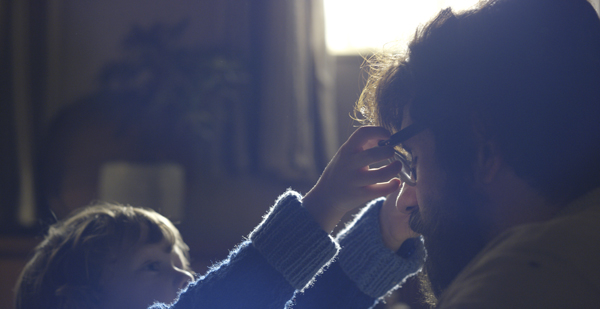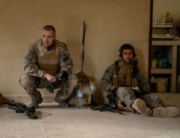
A son reaches for the glasses of his father, John Hull, as reenacted in Notes on Blindness (Gerry Floyd and BOND/360)
![]() John M. Hull had been battling blindness since childhood and multiple surgeries to reattach his retinas. In 1980, shortly before the birth of his first son, a black disc began advancing across his field of vision. His eyes by this time were so traumatized by surgeries that there was nothing left to be done. He would eventually go completely blind.
John M. Hull had been battling blindness since childhood and multiple surgeries to reattach his retinas. In 1980, shortly before the birth of his first son, a black disc began advancing across his field of vision. His eyes by this time were so traumatized by surgeries that there was nothing left to be done. He would eventually go completely blind.
Hull’s story is pulled directly from audio diaries he began recording in the 1980s to help him cope with his new reality, as well as from interviews that were recorded with him and his wife, Marilyn, by filmmakers Peter Middleton and James Spinney when they worked with Hull on a short film project in 2010. For this longer, more intimate documentary, they used actors Dan Skinner and Simone Kirby to play the roles of John and Marilyn. Skinner and Kirby lip-synch to the actual recordings as they re-create scenes from John and Marilyn’s life together.
As he’s losing his sight, Hull’s first thoughts are for his career. As an academic theologian, how will he maintain his research? How will he give his lectures when he can’t read his notes? For the next few years, as his vision wanes to shadowy images, he focuses his energies on finding ways to continue his work. Readers record on audiotape the texts of the resources on which he relies, and he learns to navigate his familiar environment using a foldable white cane. In this way, he keeps so busy that he avoids dealing with the immensity of what he is about to face. It is not until his first Christmas experienced in complete darkness that it really hits home.
Additionally, he starts to believe that there is a part of our brain that longs for optic stimulation, and without it, it will begin to die. He is haunted by his dreams, declaring that “every time I wake up, I lose my sight again,” as well as by nightmares in which he is being wheeled into a tunnel and watching the light disappear behind him. The memory of his wife’s face begins to fade, and the darkness feels like a prison from which there is no escape.
However, there are revelations and moments of enlightenment, too, such as the sound of rain that, as it drums on every surface, gives shape and dimension to the blackness around him; or an organ as it echoes through the massive stone archways of a cathedral; and his children’s voices. All are experienced as if for the first time.
Cinematographer Gerry Floyd delivers a gut-wrenching depiction of Hull’s gradual loss of sight to accompany the dialogue through clever use of lighting, blurring, and camera angles. At times the screen is completely black to augment the disembodied voices of the people around Hull. Often the view is shadowed, blurred, or only of a partial image. There is the constant sensation of not enough light and, always, the desire to rub your eyes to clear your vision. Sound editor Joakim Sundstrom amplifies and sharpens sounds to mimic how they might be experienced by someone who is blind. Original music by James Ewers and Noah Wood heightens the since of poignancy.
The documentary is a visceral immersion. After recurring bouts of panic and depression, Hull gradually comes to accept his condition, to even see it as an unasked for gift and to find a meaningful way forward. Through him, we find hope that if our greatest fear is realized, we, too, can survive with dignity and positivity. This will be a meaningful film for those who may one day find the need of a light at the end of their own nightmarish tunnel.
















Leave A Comment